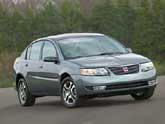Recent Articles
Popular Makes
Body Types
2005 Saturn Ion Quick Spin
Upgraded to Average

IRVINE, Calif. – Salt is the bane of automobiles that toil within a day’s drive of the 45th parallel. When it snows, this chemical is spread onto roadways to melt frozen precipitation and ice, keeping the pavement wet but clear for maximum traction. Tires pick up the salty water and spray it into the air in a fine mist, covering cars with a chalky coat of corrosive road salt. Most of a car’s exterior body parts are made of metal, which rusts easily when exposed to the salt, especially if the paint has suffered deep scratches or the car is dented and crumpled from an accident. Not only does the metal rust, but it dimples when careless fellow motorists throw open their car doors in parking lots, striking idle nearby vehicles. Rusty, dented vehicles with door dings used to be commonplace in areas such as New England and the Midwest, but new paints and protective treatments have reduced their numbers in recent years. Despite advancements in metal crafting, plastic automotive body panels make plenty of sense in urban areas, and in regions where salt is used to clear the roadways in the wintertime. Plastic doesn’t dent and it doesn’t rust. It does, however, expand and contract with the heat and cold, so it needs room to breathe. That’s why the gaps between most of the panels of the plastic-festooned Saturn Ion are large enough to swallow a pen while steel-bodied competitors feature gap tolerances tight enough to keep no more than the tip of a favorite writing instrument from fitting through. Saturn’s penchant for plastic also means that the Ion’s body panels don’t line up properly, flex when leaned upon, and make a cheap sound when the doors, fuel filler lid, and trunk lid are closed. Big gaps, poor alignments, flimsy bodywork, and a distinct lack of a solid when closing the Ion’s various apertures make the car feel less substantial than it is; they make it seem poorly designed and engineered, of lower quality, like a low budget rental car.
Page 2: Interior
Offensive describes the Saturn Ion’s interior, the place where the owner spends the most time. Design gaffes abound, made somewhat less obvious by acres of awful hard plastic that would barely pass muster at the Fisher-Price toy company. A hodgepodge of intersecting lines, mismatched textures, and an unfortunate center-mounted gauge cluster, the top of the dashboard is visually and ergonomically distressing. At night, the only main controls that are lit for easy use reside in the center of the dashboard, leaving the door-mounted power window, power door lock, and power mirror controls in the dark. Drawing undue attention to itself after sunset is an orange light on the left steering wheel spoke that glares in a sea of black when the cruise control is engaged and is virtually impossible to see when the sun is shining. Likewise, the indicator for the traction control system glows when the system is on and extinguishes when the system is off – the reverse of normal convention. Maddeningly, the upper door panels are hard where elbows rest and soft where they don’t, and the lower dash panel presses uncomfortably on the driver’s right leg as it arcs down to meet the center console. Exhibitionist black weather-stripping blatantly exposes itself on the windshield pillars, constantly reminding the driver that the Ion is, at its heart, an inexpensive commuter car and nothing more.
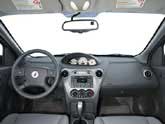
Page 3: Driving
Droning from beyond the firewall, a 140-horsepower, 2.2-liter four-cylinder engine does an acceptable job of keeping the Saturn Ion up to speed, but generates a groan more depressing than that of your spouse when the alarm clock sounds on Monday mornings. Drive over any kind of broken pavement, a common occurrence on our crumbling urban streets, and the mundane front strut and torsion beam rear axle suspension bits announce road anomalies both tactilely and aurally. Numb electric steering makes low-speed maneuvering easy, but feeds the driver no information about what is happening where the pavement meets the tires. Yester-tech rear drum brakes create dissatisfying brake pedal response that can be somewhat difficult to modulate depending on circumstances. Despite multiple reasons to complain about the Saturn Ion, a week spent behind the wheel isn’t a sentence in Purgatory. Ownership might prove different, but our 2005 Saturn Ion 3 test car served as a decent commuter and errand runner for seven days, delivering 23.7 mpg in a mix of city and highway driving. Saturn has made numerous, and welcome, changes to the 2005 Ion, and the improvement over previous models is immediately apparent.
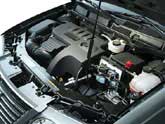
Page 4: Improvements
Walking up to the Ion 3, take note of the sedan’s new chrome-trimmed grille, revised lights, and the machine-finished alloy wheels. Body color roof trim and chrome beltline accents also decorated our test car, and the result is a handsome compact sedan with a generically upscale appearance. If only those panel gaps were tighter. Inside, though a complete redesign is the real remedy for what ails the Ion’s cabin, Saturn has at least delivered new seats for midgrade 2 and uplevel 3 trims. Our test car came equipped with leather that felt more like vinyl, but the new seats were quite comfortable. Larger and more supportive than before, they also feature a manual pump-action height adjuster that makes it easier to select a decent driving position. Other modifications include new chrome-ringed gauges on the Ion 3, metallic center dash trim for all but the Ion 1 sedan, and a larger steering wheel lifted from the racy Ion Red Line coupe. Connected to recalibrated electric steering, the new four-spoke steering wheel is far more pleasurable to use. Unlike previous Ions we’ve driven, our 2005 test vehicle exhibited little tendency to hunt and wander, and supplied much improved on-center stability. Only deeply grooved Los Angeles freeways and pavement joints tugged at the Saturn’s substantial and sticky 205/55R16 Firestone Firehawk GTA tires. Suspension modifications result in a smoother ride quality this year, though the Saturn Ion is still taut over bumps and a surprisingly competent handler in corners. Another update with a positive result is the change from the previous Aisin five-speed automatic to a tried-and-true GM Hydramatic four-speed unit. The Ion shifts more smoothly and predictably, and the new transmission hunts for gears less frequently. This change, combined with measures to reduce noise, vibration and harshness, makes the 2005 Saturn Ion far more pleasant to drive. Plus, it can be flat-towed with the new automatic, which is good news for RV owners who wish to avoid putting their car on a dolly.

Page 5: Wrap-up
Despite a laundry list of upgrades for the 2005 Saturn Ion, this remains a vehicle that is merely adequate, especially in light our Ion 3 sedan’s $19,305 sticker price. Saturn’s three-year/36,000-mile warranty coverage is half what a Kia Spectra buyer receives, and folks who select a Mitsubishi Lancer get a great warranty and free scheduled maintenance as part of the deal. Sure, Saturn dealers are still no-haggle stores that put customer satisfaction before the sale, but with most new car buyers conducting research on the Internet before setting foot in a showroom, and most dealers hungry to make a sale, it’s a buyer’s market out there. Touchy, feely sales tactics – combined with plastic dent- and rust-resistant body panels – don’t carry the weight that they did when Saturn was launched almost 15 years ago. Neither, apparently, do Saturn’s cars, which used to instill fanatical owner loyalty and inspire factory-sponsored summertime “Homecoming” events, but today stimulate little more than rebates, incentives, subsidized leases, and yawns.
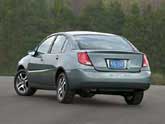
Page 6: Specifications
Test Vehicle: 2005 Saturn Ion 3 Sedan Engine Size and Type: 2.2-liter inline four-cylinder Engine Horsepower: 140 at 5,800 rpm Engine Torque: 145 at 4,400 rpm EPA Fuel Economy (city/highway): 24/32 Observed Fuel Economy: 23.7 mpg Curb Weight: 2,766 lbs. Competitors: Chevrolet Cobalt, Dodge Neon, Ford Focus, Honda Civic, Hyundai Elantra, Kia Spectra, Mazda 3, Mitsubishi Lancer, Nissan Sentra, Subaru Impreza, Suzuki Forenza, Toyota Corolla, Volkswagen Jetta
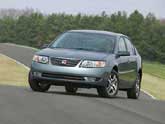
Page 7: FAQ
What are the best attributes of the 2005 Saturn Ion? Plastic body panels that don’t ding or rust, energetic handling, and comfortable front seats. What are the least appealing things about the 2005 Saturn Ion? The interior combines low-grade materials and strange design elements to create an environment that constantly reminds the owner that he or she couldn’t afford to buy a nicer car. Saturn offers plenty of help with down payments for both loans and leases. Should I take advantage of these special deals? Many automakers are offering excellent deals on small cars, and Saturn cannot sweeten the pot better than some. Even the Saturn Ion’s platform-mate, the Chevrolet Cobalt, offers a better warranty for the engine and transmission. Definitely shop around, because the Saturn Ion is not the best car in its class, even with discounts or great lease payments.
